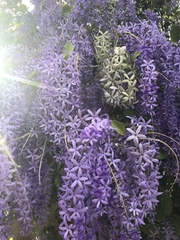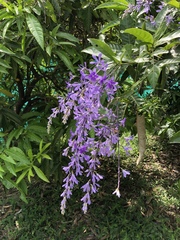
Neotropical Flora
|
Family: Verbenaceae
[Petrea aspera Turcz., morePetrea aspera f. albiflora Moldenke, Petrea kohautiana C.Presl, Petrea subserrata Cham., Petrea volubilis var. pubescens Moldenke] |
Viuda, Flor de mayo, Flor de la cruz Liana, growing into canopy, appearing to be an arching shrub when juvenile; young parts sparsely short-pubescent, glabrate in age; stems sometimes 4-angled. Petioles to 1.5 cm long; blades elliptic, often broadly so, rounded to acuminate at apex, acute to rounded at base, 7-21 cm long, 3.5-11 cm wide, usually stiff, asperous below. Racemes long, +/- pendent, upper-axillary, to ca 30 cm long; pedicels ca 11 cm. long; flowers 5-parted; calyx light violet, the tube membranous, ridged, ca 6 mm. long, the lobes 5, thin, membranous, narrowly obovate, 2-2.5 cm long, a crownlike projection occurring at summit of tube and at base of lobes, ca 3 mm. high, acutely 5-lobed to near base, often drying brown, persisting and acting as dispersal mechanism for fruit; corolla violet, salverform, ca 1.5 cm long, lobed to middle, somewhat zygomorphic, puberulent on both surfaces, the tube villous inside near apex, 1 lobe with a white spot near its base; stamens 4, fused to basal two-thirds of tube; filaments villous, ca 2 mm. long; anthers held closely together on one side of the tube at its rim; pollen somewhat sticky, adhering to anthers after being shed; style bent slightly at apex in the direction of the white-spotted corolla lobe; stigma held just below anthers. Fruits of 1 or 2 tiny nutlets completely enclosed by the persistent calyx; nutlets ovoid, ca 1.5 mm long, glabrous. Croat 9432. Abundant in the canopy and at the edge of the forest over the lake; one plant grows as an epiphyte from a large ant nest (Croat 9432). Flowering and fruiting throughout the year, often in synchronous waves throughout the forest. Petrea volubilis L. was reported by Moldenke (1973) in the Flora of Panama for BCI based on Aviles 14 and Shattuck 412 These specimens do not differ from the typical P. aspera, however, and I believe that only a single species of Petrea occurs on the island. Widespread in tropical America from northern Mexico to southern Brazil; Cuba, West Indies; widely cultivated. In Panama, known from tropical moist forest in the Canal Zone, San Blas, Veraguas, Los Santos, Panama, and Darién, See Fig. 479. |
Powered by Symbiota.

















































